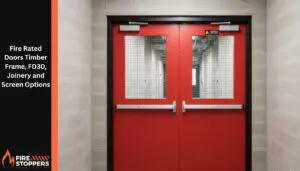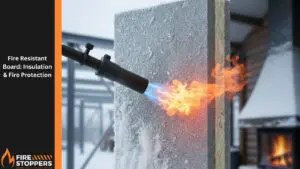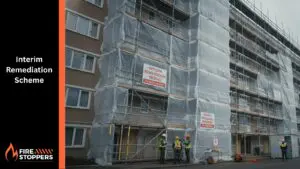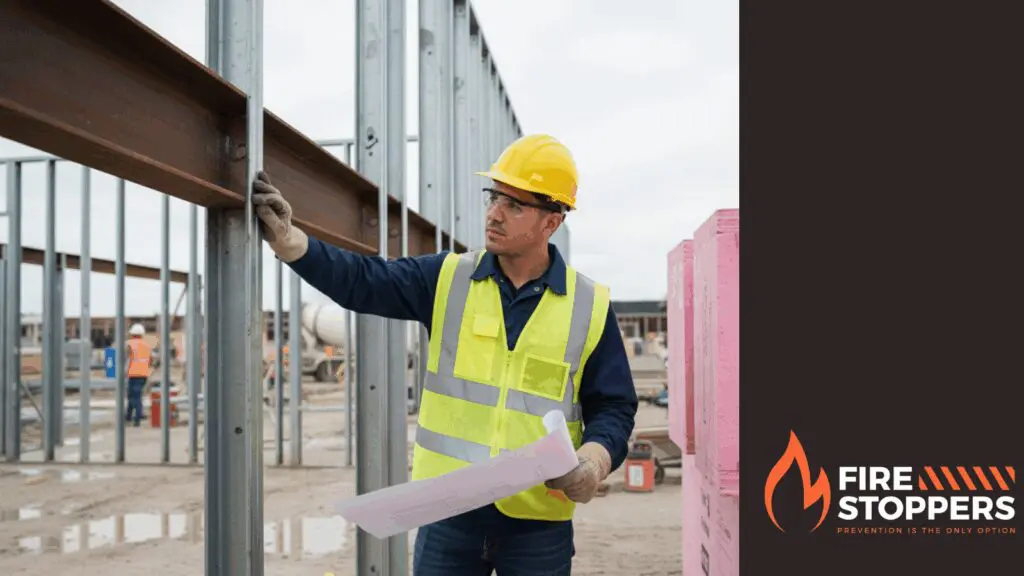
Here’s something most warehouse managers don’t want to think about: your facility could have serious fire safety gaps right now, and you might not discover them until an inspector shows up or worse, until there’s an actual fire.
With the pre-Christmas logistics rush putting massive pressure on warehouse operations across Ireland, fire safety often gets pushed down the priority list. But here’s the thing: the risks in your warehouse are different from any other building type, and generic fire safety advice won’t cut it. This guide addresses the specific challenges you’re facing in Ireland 2025, because understanding passive fire protection and Irish fire safety regulations isn’t just about ticking boxes, it’s about protecting your people and your business.
What You Actually Need to Know About Irish Fire Safety Legislation

The Fire Services Act isn’t just legal paperwork gathering dust in a drawer. It places direct responsibilities under the fire services regulations on you, the person having control over premises, to ensure fire safety, whether an outbreak has occurred or not. That’s not a threat; it’s just how the law works in Ireland.
The Health and Safety Authority enforces the Safety, Health and Welfare at Work Act 2005, which means fire safety isn’t separate from your general safety duties; it’s part of your core responsibility as an employer. The General Application Regulations spell out the specifics: you need working fire detection and alarm systems, emergency lighting that actually works when the power cuts out, and routes and exits that aren’t blocked by that “temporary” pallet stack that’s been there for three months.
Building owners must comply with Technical Guidance Document B, which sets out building construction requirements and specifies fire-resistant materials for different building types. The National Standards Authority of Ireland provides the Irish Standard specifications that guide how you should implement fire protection systems throughout your warehouse.
If you’re thinking “I’ll deal with this later,” consider that the owner or occupier can face enforcement notices, prohibition orders that shut down your operation, and prosecutions with substantial fines. More importantly, you could be responsible if someone gets hurt because you didn’t ensure the safety of occupants.
The Fire Risks Your Warehouse Actually Faces
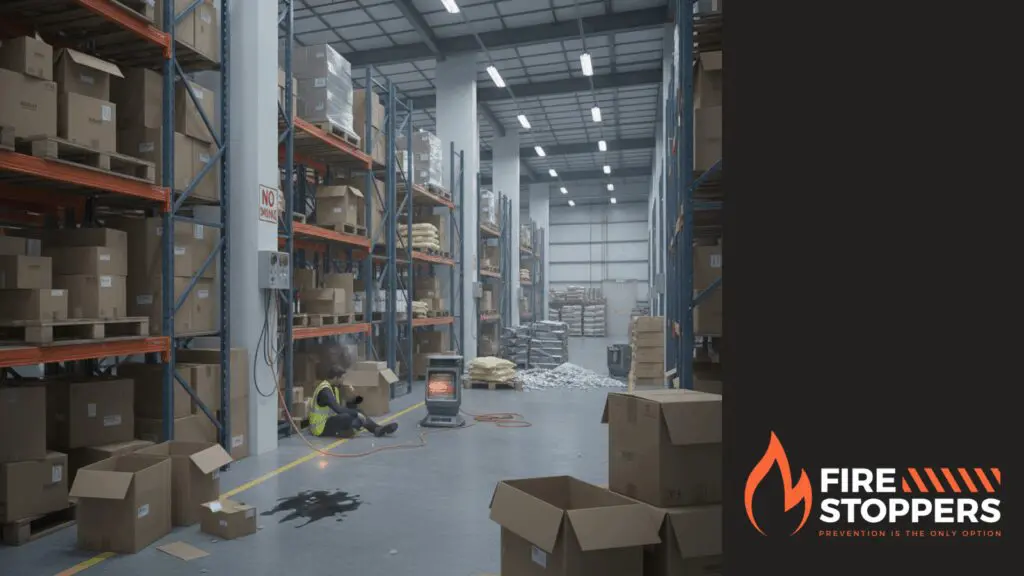
Let’s be honest about what makes warehouses particularly vulnerable to fire.
High-bay storage systems create vertical chimneys for flames. If you’ve got pallets stacked to the ceiling, you’re basically building a ladder for fire to climb. The density of combustible materials, all that cardboard, plastic wrapping, and product packaging, provides massive fuel loads. A small fire can become a serious incident incredibly quickly in these conditions.
Loading dock areas are where multiple ignition sources meet. You’ve got vehicle exhausts, occasional refuelling operations, forklifts constantly moving around, and battery charging stations for electric equipment. These areas need dedicated fire prevention protocols, not just a fire extinguisher mounted on the wall because it seemed like a good spot.
Here’s something that’s becoming a bigger problem in 2025: lithium battery storage from e-commerce returns. If you’re handling returned electronics, you’re dealing with batteries that can experience thermal runaway; they produce intense fires that are notoriously difficult to suppress. You need specific safety protocols to segregate and monitor this inventory, because these fires behave differently from regular combustible material fires.
Why Passive Fire Protection Matters More Than You Think
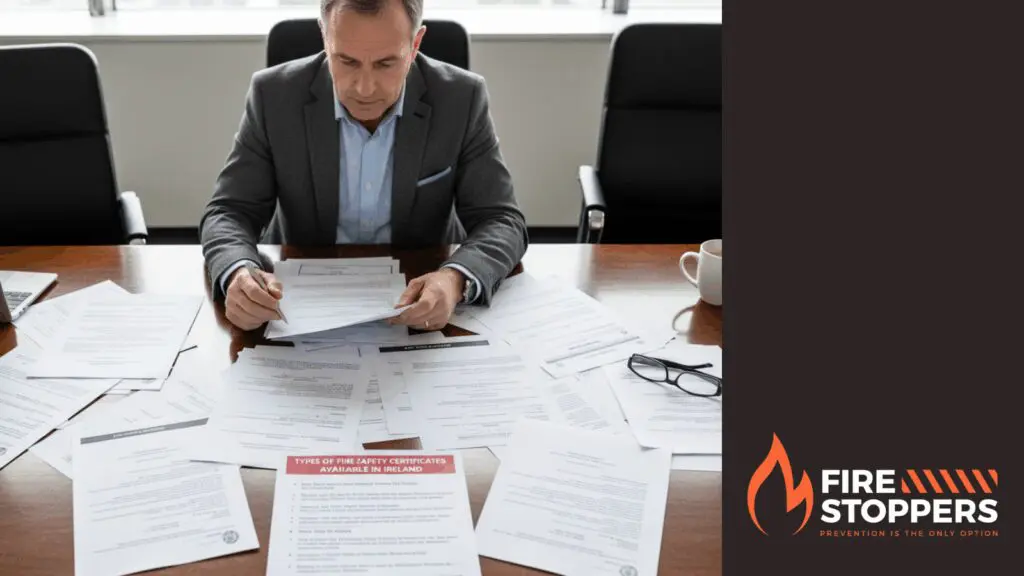
Passive fire protection is your first line of defence, and it works even when nobody’s watching. Unlike sprinklers or alarms that activate when fire is detected, passive measures are always on duty, containing and slowing fire spread 24/7.
Fire-resistant compartmentation divides your warehouse into zones. If a fire starts in one area, proper compartmentation stops it from spreading throughout the entire building. This is what prevents a minor incident from becoming a total loss that puts you out of business.
Fire doors only work if they actually close properly when needed. In warehouse environments where doors get bashed by pallet trucks daily, the intumescent seals wear out, hinges get damaged, and automatic closers stop functioning. Regular inspection isn’t optional; you need to check that these doors will do their job in the event of a fire.
Structural fire protection fire-resistant coatings on steel beams and columns, keeps your building standing long enough for people to get out and for fire services to arrive. In high-bay warehouses where roof collapse creates catastrophic risks, this protection becomes absolutely critical for occupational safety and health.
Getting Fire Detection Right in Large Spaces
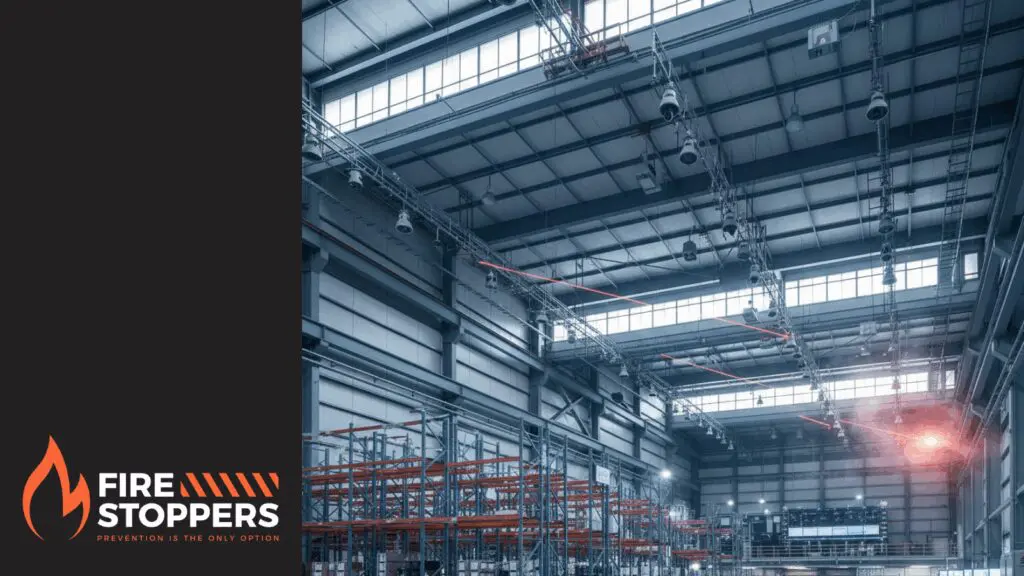
Standard smoke detectors that work fine in offices won’t necessarily work in your warehouse. High ceilings, temperature variations, and dust from constant materials handling interfere with conventional detection systems.
Modern requirements for fire detection in warehouses typically specify beam detection systems or aspirating smoke detection (ASD). ASD systems actively sample the air and can detect smoke particles before you see visible signs giving you precious extra minutes to respond.
Your fire alarm needs to be heard everywhere, including noisy zones where standard alarms get drowned out by machinery. That means proper coverage with visual warnings in high-noise areas, not just assuming everyone will hear a siren.
The best systems integrate with your building management automatically unlocking exit doors, activating emergency lighting, shutting down HVAC to prevent smoke spread, and notifying local fire services immediately. In a large facility, this automation matters because manual coordination takes too long.
Fire Sprinkler Systems: Your Best Investment for Fire and Safety
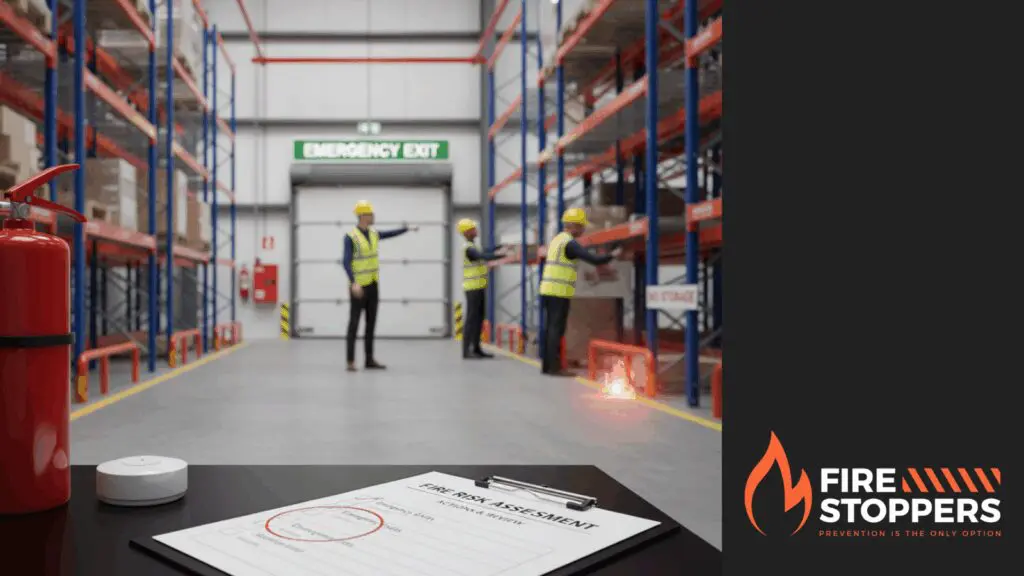
If you’re going to spend money on one active fire protection system, sprinklers should be top of your list. They’re one of the most effective fire and emergency response tools available.
Modern sprinkler design for warehouses uses specialised Early Suppression Fast Response (ESFR) sprinklers that can control fires in racks up to 13.7 metres high. But here’s what matters: your sprinkler system needs to match what you’re actually storing. High-piled plastics require different suppression capabilities than non-combustible inventory.
In-rack sprinklers position suppression closer to where fires are likely to start within your storage systems themselves. Combined with ceiling-level systems, this layered approach significantly improves your chances of controlling a fire before it becomes catastrophic.
The responsibility for fire safety includes ensuring these systems get annual inspection and testing by qualified professionals. A sprinkler system that hasn’t been maintained properly might fail exactly when you need it most.
Why You Need to Conduct a Fire Risk Assessment (And Actually Use It)

Every warehouse must conduct thorough fire risk assessments not because regulations say so, but because you need to know where your vulnerabilities are before an inspector points them out or fire officers respond to an incident.
A proper risk assessment examines three things: ignition sources (electrical equipment, hot work, smoking), fuel sources (stored materials, packaging, pallets), and oxygen sources (ventilation systems, external air). You’re looking for where these three elements could come together and create problems.
Then you prioritise. You can’t fix everything at once, so focus resources where fire risk is highest and consequences would be worst. This isn’t paperwork for compliance, it’s your roadmap for making your facility safer.
Hot work permits control welding, cutting, and grinding operations. These permits ensure someone’s thought about fire extinguishers being nearby, combustible materials being removed or protected, and maintaining a fire watch during and after the work. It’s basic fire prevention that dramatically reduces risk from maintenance and construction activities.
Making Sure People Can Actually Get Out
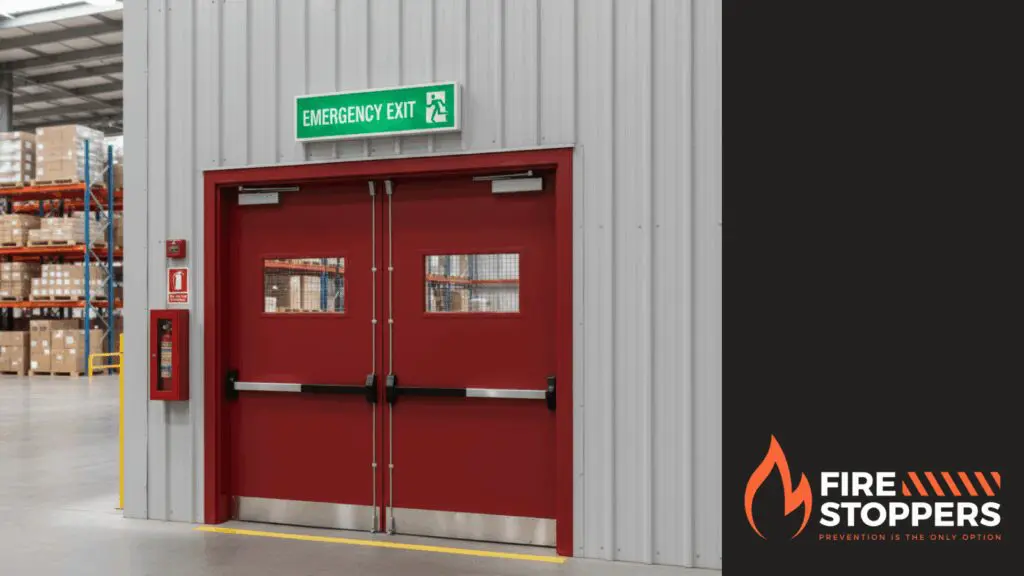
Clear evacuation routes sound obvious, but in busy warehouses, exit routes get blocked constantly. Is that temporary storage blocking a fire door? It violates Irish fire safety regulations and could trap someone in the event of a fire.
Emergency lighting provides illumination when power fails. Test it monthly, not just because you should, but because you need to know it works. When fire knocks out power and fills your warehouse with smoke, working emergency lighting could mean the difference between people finding exits or not.
Run evacuation drills that include all shift patterns. Night shift workers need to know the evacuation plan as well as day shift. Designate fire wardens who coordinate evacuation, conduct headcounts, and liaise with fire officers when they arrive. Don’t just assume everyone will figure it out in an emergency.
Fire Extinguishers: Location, Training, and Realistic Expectations
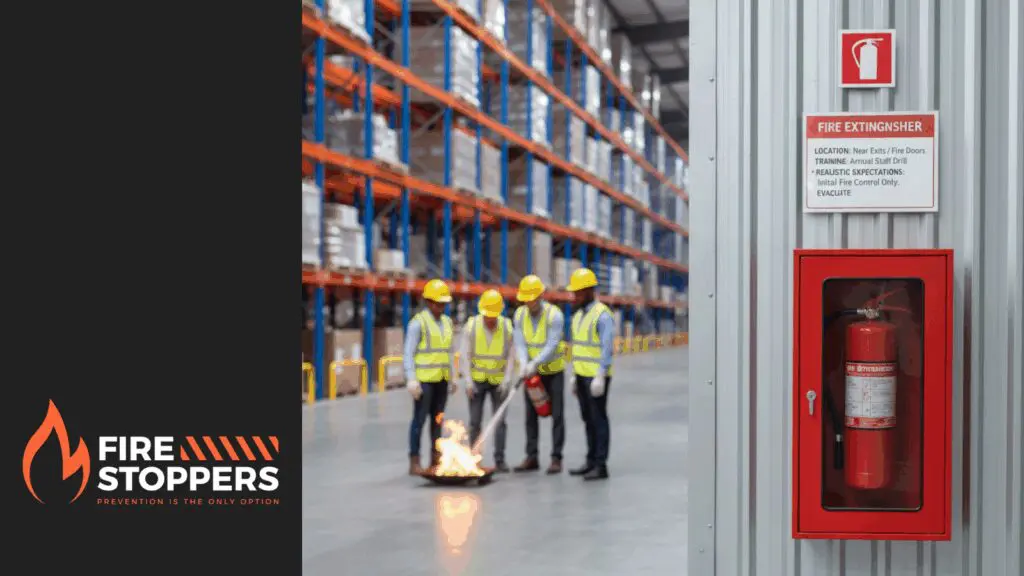
You need multiple types of fire extinguishers strategically placed: CO2 for electrical fires, foam or water for combustible materials, and specialised extinguishers if you store metals that could ignite.
Position extinguishers so nobody travels more than 30 metres to reach one. High-risk areas battery charging stations, waste compactor rooms, and office kitchens, need dedicated coverage regardless of distance requirements.
Here’s what training should emphasise: personal safety comes first. Only use an extinguisher on small, contained fires, and always maintain a clear exit route behind you. If there’s any doubt, get out and let the fire services handle it. Even if staff successfully extinguish a small fire, notify fire services anyway.
What Compliance with Irish Fire Safety Requirements Actually Means
You can’t delegate ultimate responsibility. The owner or occupier is legally responsible for fire safety compliance, even if you assign operational safety duties to managers or safety officers.
Compliance means maintaining documentation: fire safety certificates, commissioning records, inspection reports, fire risk assessments, and training logs. When building control authorities or fire officers conduct inspections, this documentation proves you take the duty of every person having control of premises seriously.
Non-compliance isn’t just about fines. It’s about facilities getting shut down with prohibition orders, business interruption that costs far more than doing things properly, and honestly the possibility of someone being injured or killed because you didn’t ensure fire safety as far as is reasonably practicable.
Keeping Standards Up as Your Warehouse Changes
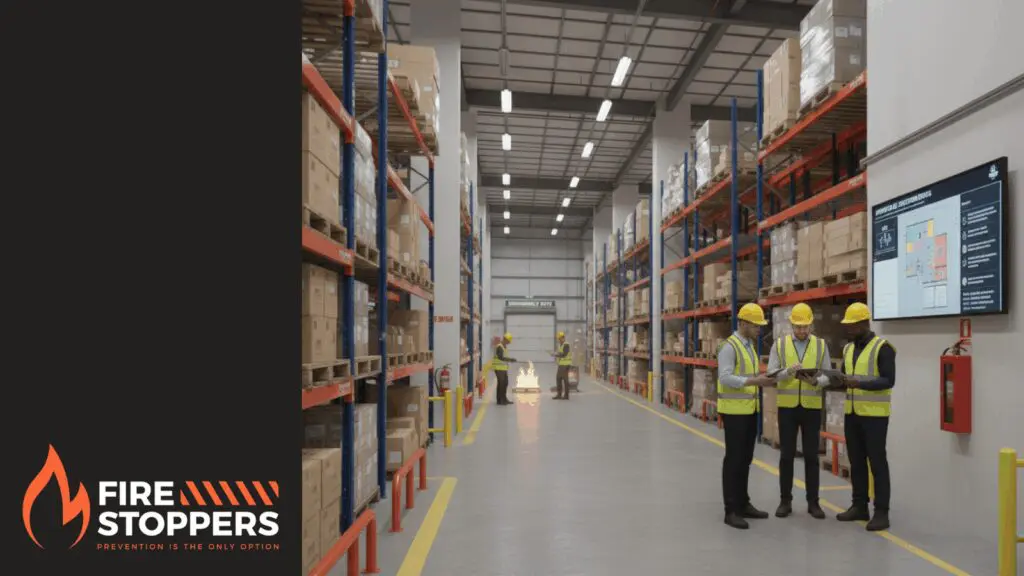
Your warehouse isn’t static. New racking systems, changed storage patterns, equipment installations these modifications impact fire safety measures and might require updated risk assessments or revised fire safety certificates.
Preventative maintenance must cover all fire safety systems: professional inspection of sprinkler systems, testing of fire detection and alarm systems, examination of fire doors, and verification that emergency lighting works. Follow manufacturer recommendations and Irish standards these aren’t suggestions.
Budget constraints never justify neglecting life safety systems. The person having control over premises must ensure fire safety receives adequate resources, because reactive responses to fire safety problems cost exponentially more than proactive investment. Ask any building owner who’s dealt with enforcement notices or actual fire damage.
Your Next Steps for Fire Safety in Irish Logistics

Fire safety in Irish warehouses requires combining passive fire protection, active suppression systems, robust detection capabilities, and solid operational safety protocols. Compliance with Irish fire safety legislation protects lives, preserves property, and keeps your business running.
The responsibility for fire safety extends to everyone working in your warehouse from management establishing policies to floor staff maintaining clear evacuation routes. Effective fire safety requires collective commitment, not just rules posted on notice boards.
As Ireland’s logistics sector keeps expanding to meet e-commerce demands in 2025, investing in fire safety measures represents sound business practice beyond just regulatory compliance. Prevention costs infinitely less than dealing with fire damage, business interruption, and potential tragedy.
If you need expert guidance on warehouse fire safety compliance, consult qualified professionals who understand the specific requirements of regulations in Ireland and can conduct fire risk assessments to ensure fire protection appropriate to your operations. You’ll fulfill both legal obligations and moral responsibilities to protect everyone who works in or visits your facility.
Start by scheduling a proper fire safety audit. Get someone qualified to walk through your facility and identify gaps. Then create a realistic plan to address the highest priorities first. You don’t need to fix everything overnight, but you do need to start, because putting it off only increases your risks and your eventual costs.
Need Fire Safety Services?
Professional fire safety solutions for your peace of mind
Contact FireStoppers Today!
For Fire Emergency: Call 999 or 112
For all other fire safety services, use the contact details above

